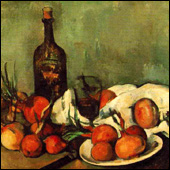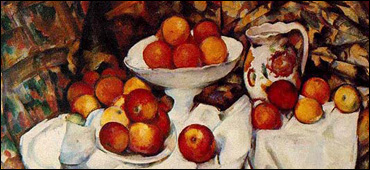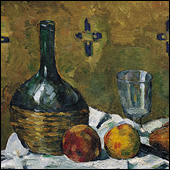 Knowing the difference between good and bad art can be difficult. You can’t always trust the art experts–many times it’s hard to even understand them. Since I believe that it’s important to make up your own mind about art, I decided to write this article to help each and every one of you judge art for yourself.
Knowing the difference between good and bad art can be difficult. You can’t always trust the art experts–many times it’s hard to even understand them. Since I believe that it’s important to make up your own mind about art, I decided to write this article to help each and every one of you judge art for yourself.
(It’s a little longer than the other articles so far, so feed the dog or put the kids to bed, and don’t say I didn’t warn you!)
There are five characteristics that you can use to determine the quality of art, ranging from the paintings in your local gallery to the strange contemporary sculpture your boss added right outside your office.
The characteristics are beauty, skill, inherent meaning, uniqueness, and fulfilled intent. I’ll explain each of these throughout this article.
Anyone can use their own fundamental knowledge to compare artwork based on these five inherent properties. Even if other people have a different opinion than you do about a particular work of art, this article should help you explain how you came to your conclusion.
Alright, so on the basis that all art is not created equal, let’s get to the nitty-gritty and break down these five characteristics of art.
1: Beauty in Art
Beauty is, and always will be, in the “eye of the beholder.” Your decision about the beauty or lack of beauty in a particular work of art is instinctive and natural. In fact, you probably won’t even have to make that decision, you’ll just either be captivated by a piece of art or you won’t.
People within the same social context often agree on what is beautiful, so you’ll probably find others close by who will like the same things that you do. Some aspects of art that generally appeal to people are:
1. Repeating shapes, patterns, and symmetry.
2. Colors, especially colors that complement or enhance each other.
3. Textures, both visual and physical (like thick, impasto paint).
4. Crops and compositions that focus the eye and keep the viewers’ attention.
5. Movement or flow to guide viewers through the art.
6. Correct or appealing proportions of figures and objects.
7. Presentation and framing.
You won’t need to take a checklist into the galleries for this since your eye will naturally be drawn to the art you prefer. As I mentioned before, this is the easy one. All you have to do is answer the question, “Do I like this?” Of course, if you decide to ask why you like it, then the list above might come in handy.

2: Skill and technique
Technical skill is the most comparable and measurable aspect of art. As you look at a painting (or any other work of art) you probably will be able to determine how skillfully it was created simply by comparing it with other works.
First, compare the works to other art you’ve seen in that medium before—if it is a painting, for example, decide whether this artist is more talented than others you’ve seen. It might be difficult if you’re just starting out, and in that case, don’t let it worry you. You will quickly learn to see the differences between a skillful painting and one that’s poorly done.
Second, look at all the artwork on display by the artist. You might find that some are more impressive than others, or appear better made, and you’ll certainly have an idea of one or two that are the best out of the group.
Third, look at each work of art itself. Are they individually consistent? Are there places where you can see odd markings compared to another area within the same piece? Sometimes art may look rushed or strange, but if it is created in a similar fashion throughout the entire piece then the effect is most likely intentional. If not, then that work may not be as good as some others that are more internally cohesive.
Judging the level of skill in a work of art is probably the most difficult thing I’m suggesting you do in this article. Over time and with more exposure to art, you will eventually come to a greater understanding of different mediums. Plus, if you’re lucky enough to be an artist yourself, you’ll probably find out that you instinctively have a decent grasp of other mediums already.

3: Inherent meaning
Art is powerful, not just for its beauty or the talent needed for its creation, but because it can cause emotion, make political statements, or challenge preconceived ideas. Of course, not all works of art are intended to be so thought-provoking. A still-life of oranges and apples, for example, usually won’t have a deeper meaning. If it does, I think the artist deserves more credit than for a traditional still life.
Here are five levels of meaning in art, which I’ve listed in order of increasing importance.
1. Purely representational art – Made simply for visual appeal, with no deeper intent.
2. Art that references other art – It “tips its hat” to some other work, possibly providing a fresh perspective or continuing a conversation that another artist began.
3. Art that tells a story, or evokes a specific emotion – This is art that begins to affect you. It might cause you to understand, empathize or feel what’s being depicted.
4. Art that makes a statement – Here the artist is clearly speaking through the work, actively promoting a cause or perhaps bringing attention to an issue that’s important to him or her.
5. Art that is an allegory or metaphor – This is art that contains more than one meaning, and possibly several. It uses symbolic imagery or deals with more intangible human issues, and yet the artwork should still work as a visually appealing creation.
Look for these when you look at art. Finding meaning or emotion in art opens up a whole new realm of enjoyment, and will deepen your appreciation of artists who incorporate it into their work.
4: Uniqueness
This is the aspect of art that relates to not only what the artist is depicting but also how the artist is depicting it.
Good art either explores new subjects or old subjects in a way that hasn’t been done before. When you look at art, ask yourself what (if anything) is different in the work from all the other art you’ve seen. Sometimes it will jump out at you, sometimes it won’t. If you do notice something different, decide for yourself whether that unique quality distracts from or enhances the piece.
There’s a happy medium, I believe, in finding art that stands out from the crowd but doesn’t use gimmicks or cause distractions.
5: Fulfilled intent
What is the artist trying to say? I hear this question a lot, and for the most part, there’s a simple way to find out. If you’re at a gallery, read the artist’s statement. Many artists just want to accurately portray a subject or express an emotion. The important thing is for the artist to be in control of the art. If the intent is one thing, the art shouldn’t say something else. The artist’s statement should deepen and strengthen the viewers’ understanding of the art.
 I’d suggest that when you go to a solo show, briefly scan all of the works being displayed so you can get an idea of the artist’s style and note any constant themes, emotions, or ideas.
I’d suggest that when you go to a solo show, briefly scan all of the works being displayed so you can get an idea of the artist’s style and note any constant themes, emotions, or ideas.
Then go through each piece of art again, but more slowly, to really study them. Take your time and determine what you think of each one according to the five characteristics mentioned in this article. After that, check out the artist’s statement.
Compare the artist’s intent with what you had previously understood the intent to be, and then armed with that knowledge (trust me, sometimes it’ll blow your mind) make one last round of the gallery to see how your opinions have changed.
If you experienced the artist’s intent before reading the statement, excellent. If you only got it after reading the artist’s statement, that’s OK too, just not quite as good.
This method keeps the art from being overshadowed immediately by what the artist is saying about his or her work. It lets the art speak for itself, yet the artist still gets a chance to clarify what is meant in case you miss the point on your own.
Of course, if you can’t even understand what the artist is saying in the artist’s statement, then just try to enjoy the art for its visual impact and don’t worry about it. The intent probably wasn’t very clear for that artist either.
To sum it all up:
Good art should appeal to you. It will be skillfully made, most likely by an artist who has created other works in a similar fashion.
The best art has meaning beyond just an image; perhaps it will bring you to tears, make you laugh, or remind you of something you’d almost forgotten. It also stands out in a crowd and dares to be different.
Most importantly (in my opinion), good art is understandable, although it may make you think in ways you never expected to.
If you’d like to take your skills in art critique further, this critique handbook is helpful to art student and enthusiast alike!
*All images in this post are details from still life paintings by Cezanne.
This post may contain affiliate links.
